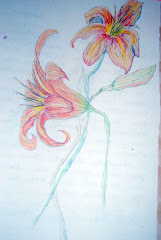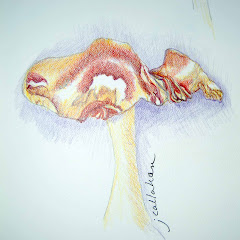



I was just remembering the day I went with naturalist Ruth Schottman to tour a bog at Lake Desolation, in the foothills of the Adirondacks; this was quite exciting because one doesn’t come across a bog everyday in these parts, and they are such unique and interesting habitats. Lake Desolation is a kettle hole bog. The original depression was formed by a retreating glacier, which deposited gravel, salt, and sand. When a block of the glacier became lodged in this sediment, its movement ceased, and when it melted, the depression, or “kettle hole” was created. Bogs are marked by the fact that they have no inlet, or outlet, of fresh water; this means that there are very low levels of oxygen, which severely limits the ability of plants to grow; as such, only certain plants, capable of adapting to this harsh, and poor nutrient condition, can survive here. Sphagnum Moss is one such plant. As it grows, it eventually drops down and fills in the bottom with decaying material called peat moss. Over thousands of years, the edges around the lake eventually fill in, and create a wet, spongy mass, on which other plants can grow.
Because there is very little decomposition of organic matter, the soil and water are a very acidic ecosystem. Due to the poor nutrients, and high acidity, only similarly adaptable life forms can take hold. One of the amazing examples of adaptive behavior is that of the carnivorous plants, which have done well in this environment. In response to the poor nutrients in the soil, these plants eventually began to supplement their diets with insects. The lovely diminutive sundew, for instance (Drosera rotundifolia) attracts insects with its bright red color and a glistening, sugary substance that covers its leaves. When insects become stuck to its glandular tentacles, it uses enzymes to extract nutrients, such as nitrates, from their bodies. Carnivorous plants also obtain phosphorous and nitrogen, both necessary for plant growth, from the bodies of their prey, as well.
The Northern Pitcher Plant (Sarracenia purpurea) another plant commonly found in bogs, uses brightly patterned leaves which exude a chemical (attractive to insects) to entice its prey. It adds the additional lure of water, which can be found in its six-inch long, tube-like leaves, partly filled with rainwater. Once the insect has found its way down to the water, it cannot escape, as the inside of the leaf is covered with downward-pointing hairs, and a waxy, slippery substance that comes off onto the insect’s feet, and prevents it from ascending. The rainwater also contains digestive enzymes, which allow the plant to digest all but the exoskeleton. But not all reach their demise when they fall to these depths, some creatures, such as a particular species of mosquito, has adapted to this environment by producing anti-enzymes that allow it to lay its eggs in the pitcher plant!
Sheep Laurel, High Bush Blueberry, Bog Laurel, Leather Leaf, Labrador Tea, Cypress Spurge, Choke Berry, Jack-in-the-Pulpit, and another carnivorous plant, Bladderwort, are some of the other interesting plants that can also often be found in a bog.




























